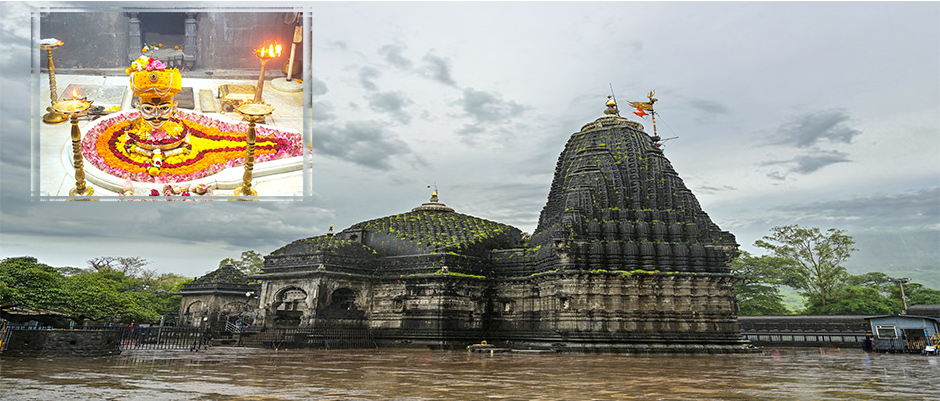
Trimbakeshwar Jyotirlinga
Trimbakeshwar Jyotirlinga: Where Divinity Rises from the Source of the Godavari
At the base of the sacred Brahmagiri hills, just 28 km from Nashik, lies the spiritually vibrant town of Trimbakeshwar. Revered for housing one of the twelve Jyotirlingas, this temple town is steeped in divine legends, historical grandeur, and eternal devotion.
The Birth of the Temple: From Ashram to Jyotirlinga
Long before the temple took its present form, Trimbak was a land of sages. One such sage, Gautam Rishi, lived here with his devoted wife. In a period of severe drought, Gautam Rishi prayed to Varuna, the rain god, to bless the land. Moved by his selflessness, Varuna brought abundant rains, reviving the earth and sustaining the many seekers who sought refuge at his ashram.
However, destiny took an unexpected turn. One day, Gautam Rishi accidentally harmed a cow with a strand of dharba grass—unaware that the cow was actually Jaya, a companion of Goddess Parvati. The other sages withdrew their blessings and distanced themselves from him.
Seeking redemption, Gautam Rishi was advised to pray to Lord Shiva and request the descent of the Ganga to cleanse his sin. He meditated on Brahmagiri for a thousand years until Lord Shiva, moved by his penance, summoned the sacred Ganga to descend. The river, emerging from Shiva’s matted locks, became the Godavari, allowing Gautam Rishi to purify himself.
This divine event gave birth to the Trimbakeshwar Temple, now a beacon of spiritual solace for millions.
A Temple Like No Other: The Three-Faced Jyotirlinga
Among the twelve Jyotirlingas, Trimbakeshwar is unique for housing a three-faced linga, representing Brahma, Vishnu, and Rudra (Shiva). These faces are naturally formed, not sculpted, and are adorned with a Pandava-era crown studded with emeralds, diamonds, and precious stones—displayed only during select rituals.
Over centuries, the continuous abhisheks have naturally eroded the linga, symbolising the impermanence of human life amid the eternal.
The Marvel of Maratha Architecture
The current black basalt stone temple was built between 1740–1760 by Peshwa Balaji Bajirao and inaugurated on 16 February 1756, coinciding with Mahashivratri. Its four cardinal gates signify stages of spiritual evolution—East for beginnings, West for wisdom, South for completion, and North for divine revelation.
Sacred Rituals Unique to Trimbakeshwar
Beyond its daily worship, Trimbakeshwar is renowned for hosting some of Hinduism’s most powerful Vedic rituals—many performed only at this sacred tirtha.
Narayan Nagbali Puja
Performed over three days at Ahilya Godavari Sangam and Sati Maha-Smashan, this ritual has two parts:
- Narayan Bali – to liberate unsatisfied or wandering souls.
- Nagbali Puja – to atone for the sin of killing a snake or cobra.
Mentioned in the Garuda Purana, performing this puja at Trimbakeshwar blesses families and future generations with peace.
Tripindi Shradha Puja
A pind-daan ritual for appeasing souls—whether from the past three generations or any unsatisfied spirit troubling descendants. If Shradha is not performed for three consecutive years, souls may become restless. This puja, done with three Brahmins, is said to remove Pitru dosh and restore ancestral blessings.
Kaal Sarp Dosh Nivaran Puja
When all planets in a horoscope are positioned between Rahu and Ketu, it forms the Kaal Sarp Yog, believed to block fortune and success. Performed at Trimbakeshwar, this puja seeks to neutralise its effects and restore harmony.
Kumbha Vivah & Mangal Dosh Remedies
For women with widow yoga or Mangal dosh in their horoscope, Kumbha Vivah is performed—marrying first to a sacred pot with Lord Vishnu’s idol before a human marriage—to remove the dosha’s ill effects. Here, rituals like Bhatpuja also address delays in marriage due to Mangal Dosh.
Mahamrityunjaya Mantra Jaap
Chanting the Om Tryambakam mantra, revealed by Lord Shiva to Rishi Markandeya, is believed to grant victory over death, heal diseases, and remove fear. At Trimbakeshwar, the mantra’s potency is magnified due to the Jyotirlinga’s energy.
Rudrabhishek Puja
A sacred bathing of the Shiva Linga with Panchamrut and Gangajal while chanting the 108 names of Shiva. As mentioned in the Ramayana, Rudrabhishek brings peace, removes negativity, and fulfills desires. Performed here, it is considered especially auspicious during Mahashivratri and Shravan Somvar.
Festivals and Fervor
- Kumbh Mela – Held every 12 years, attracting millions for a holy dip in the Godavari.
- Mahashivratri – All-night worship marking Shiva’s union with Parvati.
- Shravan Month – Daily Rudrabhisheks and special darshans.
Spiritual Hospitality
The Trimbakeshwar Temple Trust manages daily rituals and festivals, providing pilgrim facilities like Shivprasad Bhakta Niwas for comfortable stays in a serene, devotional atmosphere.
Trimbakeshwar: A Journey to the Soul’s Source
From the legend of Gautam Rishi to the sacred flow of the Godavari, from rare Vedic rituals to grand festivals, Trimbakeshwar is more than a Jyotirlinga—it is where penance meets grace, where faith transforms destiny, and where the seeker is reminded of life’s highest purpose.
The opening and closing timings of the Trimbakeshwar Shiva Temple is 5:30AM AM to 9 PM.
